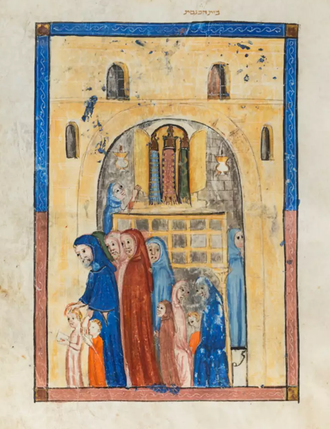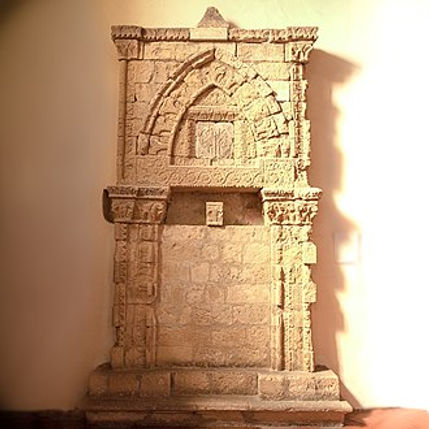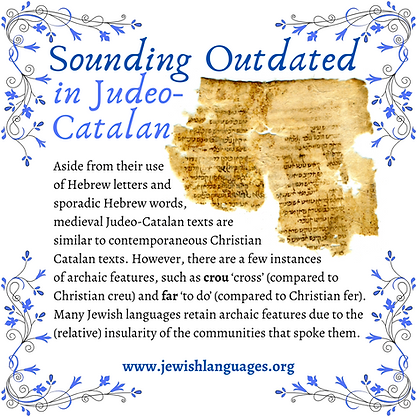Judeo-Catalan
Description by Ilil Baum
Introduction
Judeo-Catalan (also referred to as Catalanic or Catalanit, by Birnbaum and Weinreich) is a term used to describe the language variety of late medieval Jews in Catalonia, the Balearic Islands, and Valencia, and their texts written in Catalan in Hebrew script.
Like other medieval Jewish Ibero-Romance varieties (Judeo-Castilian, Judeo-Aragonese, Judeo-Portuguese, etc.), Judeo-Catalan texts exhibits a small measure of differentiation from texts written by Christians between the thirteenth century and the expulsion of Jews from the region in 1492. The distinctiveness of these Judeo-Catalan texts relies mainly on the use of Hebrew script and the insertion of Hebrew lexicon and Biblical citations.
Historical Background
A great part of the Jewish communities of the Catalan territories was under Christian rule almost uninterruptedly throughout the Middle Ages, first under the Franks and then under the kings of Aragon. Still, during the eleventh and twelfth centuries, Jewish rabbis, scholars, and scientists from the Catalan territories of Barcelona and Girona were influenced by the Jews of Sefarad, and they held great esteem for Arabic and Judeo-Arabic cultures.
During the twelfth century, the Christians advanced with the conquests of Muslim lands. Catalonia expanded its territories and Jewish communitieswith Arabized past, such as the Jewish community of Tortosa, entered the political entity of the Principality of Catalonia.
Names of language:
Judeo-Catalan, Catalanic, Catalanit, Katalanit
Territories where it was/is spoken:
Catalonia, Valencia, Balearic Islands (Crown of Aragon)
Estimated # speakers:
0
Writing systems:
Hebrew script
Literature:
Poetry, wedding songs, philosophical treatises (from Christian sources), medical recipes, legal and community documents
Language family/branch:
Ibero-Romance
Quick Facts
Similar processes affected the local and newly formed Jewish communities of Valencia and Majorca during the thirteenth century. After the end of the Muslim reign in the areas that became part of the Crown of Aragon, the Jewish communities became Catalan-speaking, as attested by trilingual documents from Majorca and Valencia, which include Judeo-Arabic, Catalan, and Hebrew (Pérez 2011; Blasco 2003).

A synagogue in Catalonia, depicted in a ca. 1350 Sarajevo haggadah (Museu Nacional de Sarajevo).

An Ark from the Catalan Jewish community of Agira, Sicily - 1453 (Aron di Agira).
Texts
Hundreds of terms and glosses in Catalan in Hebrew script are registered within Hebrew legal and commercial documents, biblical glossaries, rabbinic responsa, medical-botanical lists, and medical recipes from Catalonia, Valencia, and Majorca. The first attestations of Catalan terms in Hebrew script are documented as early as the thirteenth century. For example, forty-nine terms are documented in Rabbinic responsa by R. Solomon ben Adret (Rashba, 1235–1310) in Catalan in Hebrew script (Feliu 1989). Beyond sporadic terms and glosses, only fifteen textual units written in Catalan in Hebrew have been discovered thus far. These are mainly from the fourteenth and the fifteenth centuries and can be divided into three main groups:
1. Legal and communal documents for internal Jewish use (ordered chronologically):
-
Responsum no. 228 of Rabbi Isaac ben Sheshet Perfet, which contains two clauses copied in Catalan in Hebrew script of the Statutes of the Aljama of Barcelona, later than 1386 (Blasco & Magdalena 2005).
-
A short testimony of a Valencian mediator (Cat. corredor), Francès d’Anyó, probably a converso regarding a transaction with Gabriel Carbonel from Xativa from 1417 (Arxiu del Regne de València (ARV), Varia, n. 1068 (“Llibre de comptes del banquer Martí Bosa”), f.8b; Magdalena 1996).
-
Ordinances of the treasurer of the Aljama of Cervera, 1455 (Arxiu Històric de Cervera [AHC], Manuscrits; Duran i Sanpere 1918-1919; Blasco et al., 2005).
-
Parts of a Hebrew testament of Doña Oro from Monzon, 1463 (Archives départementales des Pyrénées-Orientales, 1 B 338; Magdalena et al. 2009).
-
A private-commercial letter between Salomó Cofen and Jucef Cavaller from Cervera, c.1485 (Arxiu Històric de Cervera [AHC], Manuscrits; Duran i Sanpere 1918-1919; Blasco et al. 2005).
2. Literature and poetry
- Original poetry:
Five wedding poems in which the base-language is Catalan, embedded with Hebrew components and Biblical quotations (Ms. OX Lyell 98, Bodleian Library, Oxford; Ms. NLI 3212=8, National Library of Israel; Lazar 1970; Riera 1974; Baum 2016; Baum 2017). The poems exhibit influences of Hebrew Andalusian poetry and of Provençal troubadour poetic features, as well as hints of prior popular Catalan or Provençal songs. Other sources indicate that Jewish poets wrote poetry both in Hebrew and in Catalan, but these Catalan poems have not yet been found. - Translation and transcription of Christian literary works:
Two fragments of philosophical treatises from the end of the fifteenth century (or early sixteenth century), which were copied by the same copyist (Ms. Vatican. ebr. 375, ff. 45a-46b; ff. 50a-51a).
The first is a fragment of philosophic definitions of Ramon Llull’s ‘Hundred Forms’ (of his Introductorium Magnae Artis Generalis), written in a mixture of Catalan and Castilian in Hebrew script (Baum 2018, 2020; Pérez 2018).
The second fragment is of a treatise by the Franciscan philosopher Petrus Thomae in Catalan in Hebrew script (Baum 2020).
A third text provides an example of the Catalanization of an Occitan literary text (=, the Arthurian Occitan legend). Five-hundred verses of this romance, which were copied by a Jewish copyist in fourteenth-century Girona, were restored from the bookbinding of the notarial books of the Historical Archive of Girona (AHG FH 71.1-FH 71.36, in the notary’s book Baum 2019).
3. Scientific works (medicine, pharmacology, magic, and alchemy):
Hebrew medical glossaries (or synonym lists), pharmacological formulations, and recipes contain medicinal-botanical terms in Catalan in Hebrew script. But only in two sources are actual Judeo-Catalan texts present; they are of medicinal and alchemy recipes and instructions, which were probably compiled and collected from different Jewish and Christian sources of the time.
-
32 recipes written in Catalan in Hebrew script are found within a collection of medical works and medical recipes in Hebrew and in Castillian in Hebrew script (Ms. Mun. Hebr. 291, the Bavarian State Library of Munich). The recipes in Catalan in Hebrew script of the end of the fifteenth century, or possibly the early sixteenth century, contain some popular and magical remedies, as well as recipes for dyeing fabric and other practical recipes for domestic self-help (Baum 2017).
-
A fifteenth-century fragment of alchemy recipes was recently identified and contains, among other things, instructions for preparing gunpowder for weapons (Gutwirth 2021). The recipes and instructions were probably copied from earlier works that circulated around Catalonia during that period.
Further information regarding Catalan-speaking Jews may be gleaned out of fragments recorded by the inquisition of converso prayers, as well as a Hebrew prayer book that includes an interlinear word-to-word translation in Catalan in Latin script (Ms. Ox. 1136, Bodleian Library, Oxford previously Ms. Bodley Or. 9).

A mikveh in Besalú, Catalonia (copyright Arie Darzi).
.jpg)
AHG. Col·lecció de manuscrits hebreus de l'Arxiu Històric de Girona, Girona-11, 17 (3a)
Features of Judeo-Catalan texts
Wexler (1988) described some distinctive features of Judeo-Catalan, while others argued that the Jews spoke a variety of Catalan that was no different from that of their Christian neighbors (Feliu 2009), and assertively ruled out the existence of “a linguistic ghost – the alleged ‘Judaeo-Catalan’” (Ferrer & Feliu, 2011). Yet, only recently Judeo-Catalan texts have been systematically studied (Baum 2017).
The limited number of texts reveals only a few distinctive lexical, phonetic, morphological, and syntactic features. Judeo-Catalan texts are marked mainly by the use of the Hebrew script and the insertion of Hebrew components in almost all of the documents and texts. While many terms relate to Jewish culture, there are examples of the use of Hebrew also for daily expressions, such as in the wedding poems: זקן zaqen ‘old man’, נערה na’ara ‘young woman’,ספינה sep̄inah ‘boat’, בחור baḥur ‘young man’. Hebrew scientific expressions appear within the medicinal recipes, such as qadaḥat temidit ‘constant fever’ and qadaḥat šelišit ‘tertian fever’. The official Ordinances of Cervera from 1455 are full of Hebrew terminology and syntagma. Many of the terms are of the religious sphere: קהל qahal ‘public, community, synagogue’; דין din ‘law’; תפילה tefilah ‘prayer’; מנודה menudeh ‘outcast, banished’; חרם ḥerem ‘excommunication’. Other terms are related to the community’s administrative and legal spheres: הסכמה haskama ‘agreement’; נאמנים ne’emanim ‘trustees, secretaries or representatives of the community’; מעמד ma‘amad ‘position’ refers to the representative council of the Jewish aljama. There is also practical vocabulary, such as הוצאות hoṣaʾot ‘expenses’; ימים yamim ‘days’; קרן qeren ‘fund’; שעות ša‘ot ‘hours’. In the wedding poems, biblical citations are at times used in a playful manner, dialoguing between the Hebrew and the Catalan (Baum 2016).
As for the Romance basis of the Judeo-Catalan texts, very few features are not to be found in other late medieval Catalan texts copied by Christians. Still, the texts exhibit a tendency towards blurring the boundaries between the spoken and the written registers. Upon writing the Romance language, Jews used their own alphabet. This entailed a greater degree of freedom from the writing conventions of literary and administrative Catalan of the period. The spoken-written characteristic manifests itself in two main ways: 1) by representing the literary language as it would have been pronounced when read aloud among learned Catalan-speaking Jews, and 2) by the immersion of spoken, popular, or dialectal traits, including rarely-documented or undocumented variants, as well as the earliest attestations of a word or a linguistic phenomenon.
Spoken tendencies of the time, which are documented both in Jewish and Christian Catalan sources are, for example: word-medial /k/ ~ /g/ interchange; /l/ > /r/ shifts; or the omission of final consonants, and especially /s/ and /t/.
.jpg)
AHG. Col·lecció de manuscrits hebreus de l'Arxiu Històric de Girona, Girona-11, 17 (16a)
Some of the phenomena in the texts could be attributed to ‘popular’ speech of medieval Catalonia. At the phonetic level, a ‘popular’ pronunciation is hinted at in the metathesis in the context of /r/, or the insertion of an epenthetic vowel, and in the reduction and shifts in consonant clusters, particularly in the context of a labial in contact with an s (-bs > -ps; -bst- > -st-), or a labial in contact with a nasal (-mb-, -mp- > -nb-; -mpt- > -mt-; -mps- > -ms-; -mpr- > -npr-; -mpl- > npl, npel; -m’n, -m’r-, -mbr- > -mr-; -mbl- > -nl-, -ml-). Some of these forms, however, may merely attest to an orthographic representation or back spelling. In terms of syntax, the pleonastic (and emphatic use) of the adverbial ablative/genitive pronoun en may also be considered a characteristic of spoken, or ‘popular,’ reflection of medieval Catalan.
Occasionally, the lexical variation may expose dialectal or regional variants, such as: aiga (cf. aigua) ‘water’; dimenge (cf. diumenge) ‘Sunday’; dinguna (cf. ninguna) ‘none (f.sg.)’, etc; In other cases, an archaic lexicon is apparent, for example, crou (cf. creu) ‘cross’ and the verb far (cf. fer) ‘to do’), or an archaic morphology (of final -ts for second person plural) in the wedding poems, most likely under Provençal influence.
Only in a few cases there is no documented ‘Christian’ counterpart, such as in single lexical items: roselló for rossell ‘egg yolk’, or benteza for bonesa ‘goodness’, where the reference could be easily discerned. However, in some cases the exact reference is unknown, e.g., pelagut, which appears twice in the medical recipes and seems to refer to some kind of herb with a sharp or spiky peel, and estonfó in the wedding poems, possibly related to a kind of estofat ‘stew’.
Undocumented forms appear in the documents and books from Girona, such as dedembre (דדימברי, instead of medieval Catalan desembre, decembre, dehembre) ‘December’. This may attest to a wider phonetic phenomenon implying an archaic and undocumented pronunciation [-ʣ-] / [-ð-]. A [-ʣ] / [-ð] pronunciation in a final position is also hinted at in another undocumented form from Girona: Felid (פליד) for Feliu (mainly for the festivity of Sant Feliu ‘Saint Felix’, but also as an anthroponym).
Hence, if put on a continuum, as suggested by Hary (2013), or by looking at the degree of distinctiveness as suggested by Benor’s (2008) Jewish Linguistic Repertoire, then ‘Judeo-Catalan’ is a ‘religiolect’, which displays only a few distinctive traits. From a sociolinguistic point of view, focusing on language ecology, a distinctive linguistic repertoire of Catalan-speaking Jews emerges (Baum 2017).

Upon examining their entire written production, particularly noticeable are Jewish written traditions and language attitudes towards Hebrew, Arabic, and Latin, as well as the blurred boundaries between the different Romance languages that they used.
In contrast to their Christian neighbors, the linguistic ecology of Jews of Catalonia, Valencia, and Majorca encompassed a Hebrew-Catalan diglossia and a belated preservation of Arabic among some learned circles.
Indeed, in centers such as Barcelona, Arabic was maintained as a scientific language (mainly among Jewish physicians), and Judeo-Arabic texts were still copied among rabbinic circles probably until the destruction of the community in the pogroms of 1391. Contrary to learned Christian scholars, Latin was not perceived as a cultural model among Jews. Admittedly, Latin became increasingly influential in Jewish writings in the fourteenth century, yet it was generally restricted to the scientific (medical and astronomic) and notarial spheres. Scientific works of Catalan Jews integrate terms from Hebrew, Arabic, Latin, Catalan, Provençal, Castilian, Aragonese, and at times from other Romance languages (Bos & Mensching 2015).
Thanks to Jewish intellectual ties and geographical mobility throughout the Iberian Peninsula and beyond, the linguistic frontiers between the different Romance languages with which the Jews came into contact were sometimes blurred. This is demonstrated by the leʿazim in the Biblical glossaries and the botanical-medical lists from Catalonia (fourteenth-fifteenth centuries).
The general process of Castilianization among Catalan court circles during the late fifteenth century impacted the Jews as well, prior to their expulsion (Baum 2018). The prestige of Castilian and the greater number of exiled Castilian Jews could explain, in part, the fast absorption of Catalan Jewry within a post-expulsion Judeo-Spanish culture. The latest examples of Catalan in Hebrew script may be dated to the early sixteenth century, and the imprint of Catalan is only minorly detected within Judeo-Spanish texts after 1492.
To cite: Baum, Ilil. n.d. Judeo-Catalan. Jewish Language Website, Sarah Bunin Benor (ed.). Los Angeles: Jewish Language Project. https://www.jewishlanguages.org/judeo-catalan. Attribution: Creative Commons Share-Alike 4.0 International.
